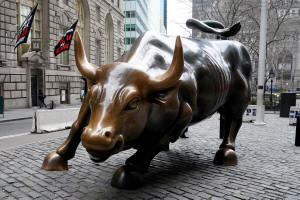Analysis-U.S. bond investors worry deep slide will end 40-year bull
market
 Send a link to a friend
Send a link to a friend
 [April 30, 2022] By
David Randall [April 30, 2022] By
David Randall
NEW YORK (Reuters) - The 40-year bull
market in U.S. bonds is dead. Long live the bond bull market.
The U.S. Treasuries market began 2022 with one of its biggest slides in
history. Some bond investors are again worried that the end is at hand
for the decades-long run in U.S. debt, which took yields on the
benchmark 10-year note from a high of 15.3% in 1981 to 0.54% in March
2020.
But U.S. Treasury bears have a spotty track record on Wall Street. The
bond market has invariably bounced back from past selloffs thanks in
part to modest economic growth rates and a comparatively dovish Fed.
The bearish view has gained traction now, however, as the Federal
Reserve signals it is ready to employ big rate hikes and a speedy unwind
of its balance sheet to bring down inflation from 40-year peaks.
"Bonds were the bull market for the last 40 years, but they will be one
of the bear markets of the 2020s," said Michael Hartnett, chief
investment strategist at Bank of America Global Research.
Yields on the 10-year benchmark US Treasury - which move inversely to
prices - are up 136 basis points this year at 2.87%. The ICE BoFA US
Treasury Index has dropped near its lowest levels since May 2019.

Bonds were one of the largest short positions among global fund managers
in a recent Bank of America Merrill Lynch survey. Investors have pulled
money from bond funds on net for the last 10 weeks, the longest losing
streak since the end of 2013, ICI data showed. The iShares 20+ Year
Treasury Bond ETF, the most heavily traded bond-focused exchange traded
fund, is down 18% this year.
Hartnett believes 10-year yields could hit 5% in coming years, noting
there may be tactical buying opportunities despite the bearish secular
outlook. Such a move would put yields at their highest level since 2007.
Deutsche Bank analysts echoed the forecast of a 5% Treasury yield peak
in a note earlier this week, which also said aggressive Fed tightening
could send the economy into a “significant recession” next year.
Another red flag: comments from Fed Chair Jerome Powell earlier this
month on “front-end loading” the Fed’s hiking cycle. Some investors have
now penciled in 75 basis point increases at the Fed's June and July
meetings, following an expected 50 basis point hike at next week’s Fed
meeting.[L2N2WK1MC]
A sustained period of bond weakness could have far reaching effects,
from weighing on companies’ borrowing costs to hurting investors’
portfolios.

[to top of second column] |

The Charging Bull or Wall Street Bull is pictured in the Manhattan
borough of New York City, New York, U.S., January 16, 2019.
REUTERS/Carlo Allegri

Treasury holdings among individual investors and mutual funds stood at $4.39
trillion at the end of 2021, data from Securities Industry and Financial Markets
Association showed. Bonds overall make up some 20% of 401(k) accounts, according
to Morningstar.
“People are going to face for the first time in decades what it means to have
significant declines in their bond portfolios," said Jim Paulsen, chief
investment officer at the Leuthold Group. "It’s unique, it’s outsized, and it
hurts.”
For stocks, the impact of higher Treasury yields has depended on whether they
are accompanied by rising consumer prices, a study by LPL Financial showed –
potentially spelling troubling for equities in today's super-charged
inflationary environment.
Stocks notched an average gain of 6.4% in 13 periods of rising bond yields
between 1962 and 2016, compared to the index’s long-term average of 7.1% during
that period, the 2021 study showed.
When yields rose and inflation was high, however, the average annual return fell
to -0.4%.
The view that bonds are headed for years of losses is far from universal. Some
investors believe the Fed will successfully tame inflation, allowing them to
eventually pull back on monetary policy tightening. [L2N2WJ0W3]
Andy McCormick, head of Global Fixed Income at T. Rowe Price, said his funds
have been buying 10-year Treasuries, gauging that much of the Fed’s tightening
is already priced in.
The selloff may also be attracting foreign buyers into Treasuries, potentially
helping stabilize prices – at least in the short term.
A NatWest’s report said the 3% mark - which yields have failed to breach - may
be a “psychological level” that draws foreign buyers.

Demand from foreign buyers at the two-year Treasury auction earlier this week
was the second highest ever in percentage terms, said Lou Brien, a strategist at
DRW Trading Group.
Ash Alankar, Head of Global Asset Allocation at Janus Henderson, plans to buy
bonds when real yields – a measure of Treasury yields adjusted for inflation --
turn positive for a sustained period.
“Bonds won't have the same historic return in the decade ahead, but they will
still be attractive," he said.
(Reporting by David Randall; Additional reporting by Saqib Iqbal Ahmed; Editing
by Ira Iosebashvili and David Gregorio)
[© 2022 Thomson Reuters. All rights
reserved.]This material may not be published,
broadcast, rewritten or redistributed.
Thompson Reuters is solely responsible for this content. |